The Ridgeway
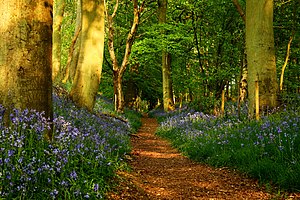
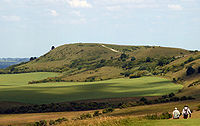
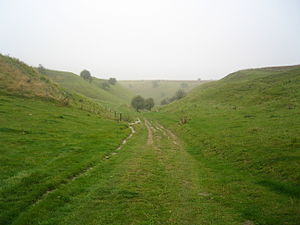
The Ridgeway is a ridgeway or ancient trackway described as Britain's oldest road. The section clearly identified as an ancient trackway extends from Wiltshire along the chalk ridge of the Berkshire Downs to the River Thames at the Goring Gap, part of the Icknield Way which ran, not always on the ridge, from Salisbury Plain to East Anglia.[1] The route was adapted and extended as a National Trail, created in 1972. The Ridgeway National Trail follows the ancient Ridgeway from Overton Hill, near Avebury, to Streatley, then follows footpaths and parts of the ancient Icknield Way through the Chiltern Hills to Ivinghoe Beacon in Buckinghamshire. The National Trail is 87 miles long.
History
The theory of ancient long-distant trackways is not without controversy, but the general belief is that some long-distance paths such as the Ridgeway have been used for perhaps 5,000 years. The Ridgeway runs along the ridge at the top of the Berkshire Downs and perhaps on across the Thames at the Goring Gap: the long-distance national trail today follows the route from Overton Hill, near Avebury in Wiltshire along the ridge, oacross the Thames and along the ridge of the Chilterns as far as Ivinghoe Beacon in Buckinghamshire.
One theory is that the ridgeway is 5,000 years old and that it may originally have been connected to the Dorset coast, providing a reliable trading route to The Wash in Norfolk. The high dry ground made travel easy and provided a measure of protection by giving traders a commanding view, warning against potential attacks.
Hereabouts are a number of sites believed to date from the Bronze Age; the Uffington White Horse in Berkshire and the stone circle at Avebury. During the Iron Age, inhabitants took advantage of the high ground by building hill forts along the Ridgeway to help defend the trading route. Following the Romans’ retreat from Britain in 410, turmoil again engulfed the land until the establishment of the West Saxon kingdom, but inthtese times, and in the later Danish invasions, the Ridgeway was used by armies.
Throughout history, in peace and war, the Ridgeway has been a droving route, on which herds and flocks had been brought from the western counties to markets in the towns and to London.
Before the Enclosure Acts of 1750, the Ridgeway existed as an informal series of tracks across the chalk downs, chosen by travellers based on path conditions. Once enclosures started, the current path developed through the building of earth banks and the planting of hedges.
National Trail
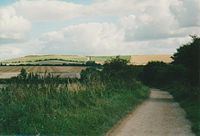
The idea for a long-distance path along the line of the Wessex Downs and Chilterns goes back to the Hobhouse Committee in 1947. The present route was designated by the Government in 1972, and opened as a National Trail in 1973.[2] This formalised the route of what had been a series of paths.
One of fifteen long-distance National Trails in England and Wales, the Ridgeway travels for 87 miles northeast from Overton Hill within the Avebury World Heritage Site to Ivinghoe Beacon near Tring, where it meets the Icknield Way Path. The Ridgeway meets the more recent (1997) Thames Path National Trail at the Goring Gap, where both trails use opposite banks of the River Thames between Goring-on-Thames and Mongewell; the Thames Path following the western bank and the Ridgeway the eastern. The Ridgeway represents one of four long distance footpaths which combine to run from Lyme Regis to Hunstanton, collectively referred to as the Greater Ridgeway.
Sights along the trail
The Ridgeway passes near many Neolithic, Iron Age, and Bronze Age sites including Avebury Circle, a stone circle similar to Stonehenge; Barbury Castle, Liddington Castle, Uffington Castle, Segsbury Castle, Pulpit Hill and Ivinghoe Beacon Hill, all Iron Age and Bronze Age hill forts; Wayland's Smithy, a Neolithic chieftain burial tomb; the Uffington White Horse, an ancient 400-foot chalk horse carved into the hillside near Uffington Castle; and Grim's Ditch, a 5-mile section of earthwork near Mongewell created at an unknown age as a possible demarcation line.
Other points of interest include the Blowing Stone, and Victory Drive, the private drive of Chequers (the British Prime Minister's country retreat near Ellesborough in the Buckinghamshire Chilterns).
Surface
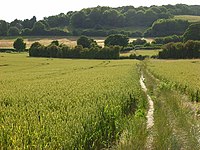
The Ridgeway's surface varies from chalk-rutted farm paths and green lanes (which have a propensity for becoming extremely muddy and pot-holed after rain) to small sections of metalled roads. Labelled a bridleway (shared with horses and bicycles) for much of its length, the Ridgeway also includes parts designated as byway which permits the use of motorised vehicles. Local restrictions along many byway sections limit the use of motorised vehicles to the summer months.
Under the Countryside and Rights of Way Act 2000, many public rights of way in England and Wales that authorities had not explicitly classified as Bridleway or Byway defaulted to the classification "Restricted Byway" which precludes the use of motor vehicles at all times, except authorised vehicles and where required for access. As a result, much of the Ridgeway remains prohibited to motor vehicle use by the general public year round.[3] However, the Ridgeway is the only means of access for many farms, especially in the more remote parts of the downs.
Despite the Ridgeway's artificial creation, the TV programme Seven Natural Wonders featured it in 2005 as one of the wonders of the South.
Places along the Ridgeway
Places that are near to (or on) The Ridgeway National Trail include (from West to East):
|
|
|
|
|
References
- ↑ Darvill, Timothy (2002). Oxford Archaeological Guides: England. pp. 297–298. ISBN 0 19 284101 7.
- ↑ Curtis, Neil (1994). The Ridgeway National Trail Guide. p. 18. ISBN 1 85410 268 0.
- ↑ "Ridgeway given 22-mile motor ban". BBC. 2006-05-22. http://news.bbc.co.uk/1/hi/england/oxfordshire/5005478.stm. Retrieved 2007-11-05.
Maps
- Annotated map of the Ridgeway
- Ridgeway National Trail. Published by Harvey Maps, UK.